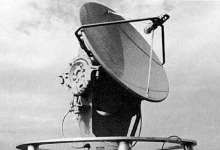W-160
Description of the radar set, tactical-technical characteristics

Figure 1: W-160 without radome
| Specifications | |
|---|---|
| frequency: | 9.7 … 9.9 GHz
(I-Band) |
| pulse repetition time (PRT): | |
| pulse repetition frequency (PRF): | 1 560 … 125 000 Hz |
| pulsewidth (τ): | 0.25 or 8 µs |
| receive time: | |
| dead time: | |
| peak power: | 16 kW |
| average power: | |
| instrumented range: | 75 km |
| range resolution: | |
| accuracy: | |
| beamwidth: | 1.8° |
| hits per scan: | |
| antenna rotation: | 15, 20 and 25 min-1 |
| MTBCF: | 600 hrs |
| MTTR: | |
W-160
The W-160 is an operating in I-Band shipborne multifunction naval radar. The primary functions of the W-160 are the generation of accurate track data for effective fire-control and target illumination for surface-to-air missiles.
The W-160 employs technology developed for the AN/APG-66 and AN/APG-68 families of airborne fire-control radars. The W-160 consists of an antenna assembly and two equipment cabinets. The antenna assembly contains the parabolic antenna with a diameter of 1.22 m, using a monopulse feed with vertical polarization, pedestal and radome. The transmitter uses a Traveling Wave Tube. The receiver uses pulse compression with a compression ratio of 13:1 and a moving target indication with a 3-pulse canceller and an improvement factor of 57 dB.
The W-160 is an outdated technology that is still in use in the Taiwanese Navy.
